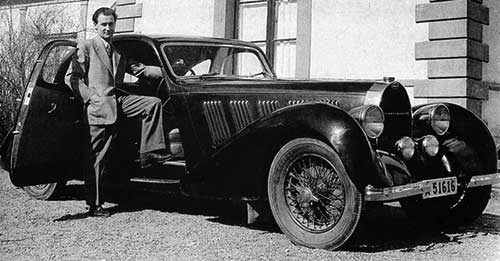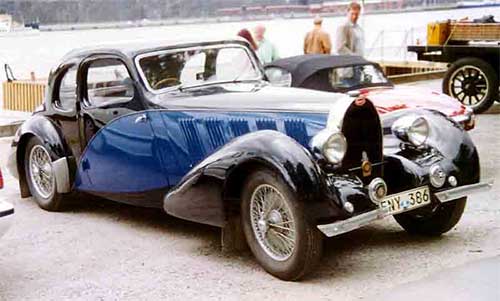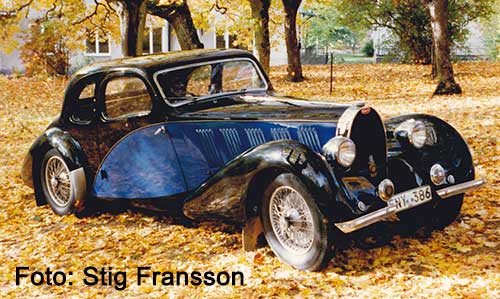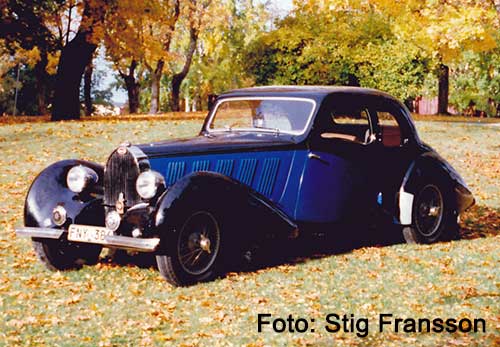|
Bugatti
Type 57 was first produced in 1934 and was
gradually modernized until the beginning of the
war, including the sportier and lower 57S and
the supercharged 57C. The model was largely
engineered by Ettore's son Jean who increasingly
took over more and more of his father's
responsibility for the factory. This was the
first model with the new leadership and in many
ways groundbreaking. It had a newly developed
type of engine, a 3.3-litre straight eight with
dual overhead camshafts (but still with the
cylinder head cast in one piece with the engine
block) which gave 135 hp at 5000 r/m. They were
driven by helical gears instead of chains. The
vehicle had a gearbox that for the first time
with Bugatti was not separate but bolted to the
engine, in combination with a single-plate disc
clutch instead of the previous complicated multi
plate. The engine type was further developed for
use in the racing car type 59.
Jean Bugatti wanted to introduce a new
independent front suspension with transverse
leaf springs - but that was the limit of what
the conservative Ettore Bugatti could withstand.
He demanded that the cars would have the classic
elegantly curved tubular front axle that has
existed virtually from the start. The brakes
were as previously mechanical and worked by
wires.
A large part of the model's success was due to
the beautiful body types that Jean Bugatti
designed for the new model - long, sweeping
lines, but in a classic style. For the first
time some bodies were made at the factory, but
most were built by famous coach builders. Of
course, there were many who bought a chassis and
ordered a beautiful body from a skilled
coachbuilder - there
were still quite a number of those in Europe.
The standard bodies offered had been designed by
Jean Bugatti and were named after famous Alpine
peaks: the Galibier, the Stelvio, and Ventoux
and usually built by the factory, but they could
also be ordered from various body manufacturers
using factory blueprints. Later came two very
sophisticated coupé models with names from the
Greek mythology, Atlantic and Atalante. There
was also a supercharged version, 57C. Total
production was 630 cars of types 57/57C.
Our Type 57 was sold in August 1936 to Bugatti
agent Bucar in Switzerland and bodied by the
well-known coachbuilder Graber. It was
originally a 2-door coupé, but was later
converted by Graber to a very elegant 4-seater
coupe.
Just after the war the car was imported to
Sweden and the new owner consulted Curt
Borgenstam about some problems with the clutch.
Curt Borgenstam (who was a good friend of Bertil
Lindblad) bought the car in 1951 and drove it to
Molsheim to have the engine overhauled. It was
discovered that the front axle was incorrectly
positioned, probably in connection with the
replacement of the mechanical brakes by
hydraulics before the war. This had been done in
the wrong way and the braking system was now
changed to the type of Lockheed brakes as the
model was supplied with since 1938. After that
the car handled as well as a modern car.
For several years Curt Borgenstam had his car
for everyday use, but also for long trips
abroad. For example he, together with Bertil
Lindblad and two automobile friends, undertook
a long
trip to Germany, France and England to meet
other like-minded people, mainly Bugatti owners.
The car was used by Curt Borgenstam in many
rallies for old cars and he kept it until his
death in 1999 when it was donated to the
foundation. It is ready for operation and is
used occasionally for rallies and
demonstrations.
Björn-Eric Lindh 2015
|
Technical
data |
|
Make:
Bugatti |
|
Type/Model:
57 |
|
Body:
Coupé |
|
Year of
manufacture:
1936 |
|
Engine:
8-cylinder
in-line engine
with dual
overhead camshafts |
|
Cylinder
capacity:
3257 cc |
|
Power:
about 135 hk? |
|
Gearbox:
4-shift plus
back |
|
Brakes:
Hydraulic
4-wheel brakes |
|
Wheelbase:
3300 mm |
|
Maximum
speed:
about 150 km/h |
|
Manufactured
quantity:
546 |
|

Curt Borgenstam and his Bugatti type 57 1936.

The photo was
taken in Stockholm in the 1990s when Curt
Borgenstam participated in a motoring event.




|